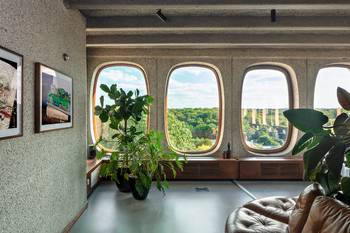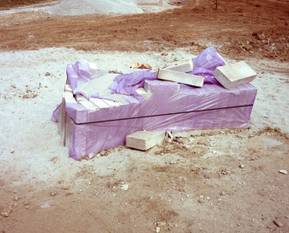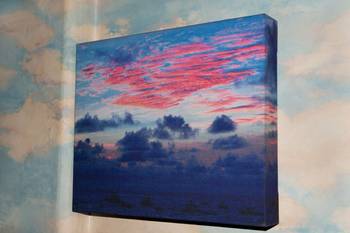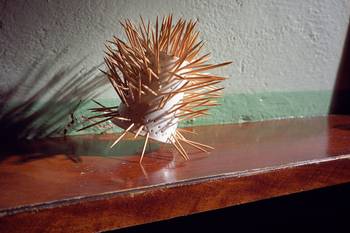Since the 1980s, Peter Fraser and his colleagues Martin Parr and Paul Graham have been pioneers of contemporary colour photography in Great Britain. His still lives are now being exhibited in a modernist architectural gem in Watermael-Boitsfort.
© Karin Borghouts
In 1970, the Polish-Belgian architect Constantin Brodzki designed a modernist office building for the cement company CBR. The office, with large, golden aeroplane-style windows and concrete walls, boasts views across the Sonian Forest. Seven floors of the building are currently occupied by the Antwerp-based company Fosbury & Sons, who use it as a co-working space.
On the eighth floor, the British photographer Peter Fraser is presenting work spanning his almost forty-year career. “In 2013, I was very privileged and honoured to be invited as the first living British photographer working in colour to be offered a Tate retrospective exhibition,” he tells me. “All of these works were in the Tate show, but that exhibition was of course much bigger.” His exhibition in Brussels was curated by Kaat De Jonghe from Die Plek, a gallery that has no fixed address and which exhibits photographers’ work in unusual locations.
What is the single leitmotif that runs through all the bodies of work that you’ve made?
peter Fraser: All through my career, I’ve been inspired by a visceral experience of standing in front of the subject and sensing its extraordinary presence in addition to whatever else it might be besides what it appears to be about. In other words: if I’m looking at pink polythene wrapped around concrete building blocks, I am thinking and I am feeling that I’m looking at building materials surrounded by a beautiful, coloured plastic. But at the same time as being amazed at how beautiful such a simple elementary everyday subject can be, I’m also very interested in more profound aspects of vision of what is real.
You are searching for what is real. Does that mean that what we see is not real?
Fraser: Yes. It’s both. What I’m looking at in the physical world is a construct. My mind tells me that it exists in a meaningful sense but there are other ways that the mind can tell you that something is real. It can also tell you it’s a vision and it doesn’t really exist. So for 37 years I’ve been trying to discover and understand better what is real.
You did not study art but were trained as a technical photographer. When did you become aware that you can make art with photography?
Fraser: As a young boy, my mother used to play classical music on Saturday mornings. My father went to the pub to drink with his friends because he hated classical music. My mother also painted. I think because she used to play classical music, I was profoundly inspired by the idea that a musician and therefore an artist could devote their whole lives to personal self-expression. From an early age, I realized that it was possible to be an artist whether you were a musician or a painter or a photographer. And the point was, even though artistic photography in the 1960s was a very new thing, I knew implicitly that photography could be like painting, music, sculpture, writing, poetry, and so on.
With fellow students who aspired to careers in fashion or advertising, it must have been difficult to find role models. Who inspired you?
Fraser: When I was a student, who were the people who inspired me? Edward Weston, Paul Strand, not Henri Cartier-Bresson. I was very interested in the intensity of the images of those very painstaking camera people who generally used plate cameras. Then I saw William Eggleston’s work; I was electrified by his work. Eggleston’s early photos were like psychological triggers. His photograph of a lorry, for example, almost suggests that the lorry is self-aware. That’s big stuff, that is a big idea, that is a big experience for a viewer of photographs to receive and to understand.
William Eggleston is the godfather of colour photography. Have you ever met him?
Fraser: In 1983, he had his first ever exhibition in the V&A in London. My friend and fellow student Martin Parr was getting invitations to openings at the V&A. I wasn’t because I wasn’t important enough. But Martin couldn’t make it, so very kindly he said: “Peter would you like my Eggleston opening invitation?” And I said: “Yes!” I knew I had to go there and ask Eggleston if I could come and work with him in America. Everybody told me that it was impossible but I had to give it a try. I’d been told he liked to drink. So I thought at some point he would go over to the bar table and get a drink and after about 20 minutes he did. And when he walked to the bar all by himself, I shot over and introduced myself and said: “Mr Eggleston, can I introduce myself? My name is Peter Fraser, I’m extremely interested in your work and I’m shooting in colour. Can I come and work with you next year in the States?” He looked me in the eye very seriously and he said: “Do you teach?” I had taught but I wasn’t teaching at that time, so I said no. It was the truth but it was probably also the right answer. So we arranged it all and at the beginning of July 1984, I flew over to Memphis and started an amazing experience. I spent seven weeks shadowing him but I didn’t dare to show him my portfolio until the very last day. He said: “Your work is brilliant. Go for it!” Thank God. (Laughs)
PETER FRASER: WHATNESS >5/10, CBR building/Fosbury & Sons
Read more about: Watermaal-Bosvoorde , Expo , culture , Expo , peter fraser , Photography








Fijn dat je wil reageren. Wie reageert, gaat akkoord met onze huisregels. Hoe reageren via Disqus? Een woordje uitleg.